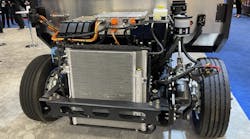EVs are sexy—in their own way.
And with so many vehicles, components, and charging hardware on or coming rapidly to the market, there's a lot to check out. At least there was at Work Truck Week 2022, which featured ride-and-drives of some of the latest chargeable commercial steel. (FleetOwner is featuring images from WTW with this story and Part 1 and Part 2 of our series before it.)
It was appropriate, then, that one monster OEM and supplier announcement, two weeks prior to the Indianapolis vocational show, brought home the notion that spring 2022 is EV season.
To accelerate the development of electrified commercial vehicles, Cummins announced earlier this year that it would acquire Meritor Inc., a global provider of drivetrain, mobility, braking, aftermarket, and electric powertrain solutions. The Cummins-Meritor deal is valued at $3.7 billion.
The deal is expected to position Cummins as one of the few companies able to provide integrated powertrain solutions across internal combustion engine (ICE) and electric power applications. Cummins leadership stated that this is “the right time to pursue this combination” as demand for decarbonized solutions accelerates.
See also: Traton boosting its trucking electrification investments
Cummins also noted that it believes e-axles will be a critical integration point within hybrid and electric drivetrains. Last year, Meritor began production of its 14Xe all-electric, fully integrated, commercial electric powertrain for medium- and heavy-duty commercial vehicles.
If that wasn't enough, Eaton also launched a new ePowertrain business unit that will focus on products from its electrified vehicle transmission, reduction gearing, and differential portfolios.
Combining the product lines into a new ePowertrain business unit aims to align Eaton’s powertrain and EV experts and allow the Vehicle Group to offer its global customers solutions for commercial and light-duty EVs, according to Eaton.
See also: Xos delivers electric step vans to SoCal operators
“Automakers face many challenges when developing an EV powertrain, such as optimizing efficiency, weight, and noise, vibration, and harshness (NVH), and dealing with packaging constraints,” said Anthony Cronin, product director of EV gearing and differentials for Eaton’s Vehicle Group.
Eaton’s transmissions include 2-, 4-, and 6-speed electrified commercial vehicle transmissions. According to Eaton, the EV setups feature lightweight countershaft gearboxes that boast a range of torque capacities and electric gearshift actuation, allowing use of smaller electric motors.
Eaton’s Vehicle Group also offers a range of specialized differentials for EVs with performance comparable to differentials designed for traditional ICE vehicles, the company noted.
Mack Trucks joined the party by introducing its Range Calculator for Electric Vehicles to help fleets plan and build routes for the Mack LR Electric refuse truck based on route-specific variables.The next-generation LR Electric, which was launched in March, features 42% more energy and a standard 376 kWh total battery capacity for increased range. The Mack LR Electric features twin electric motors, offers 448 continuous horsepower and 4,051 lb.-ft. of peak output torque from zero RPM. The LR Electric has a two-speed Mack Powershift transmission, Mack mRIDE suspension and Mack’s proprietary S462R 46,000-lb. rear axles.
The LR Electric is equipped with four NMC (Nickel Manganese Cobalt Oxide) lithium-ion batteries that are charged by a 150kW SAEJ1772-compliant charging system. Along with vehicle propulsion, the four batteries also provide all power for every onboard accessory, driven through 12V, 24V and 600V circuits. The two-stage regenerative braking system helps recapture energy from the hundreds of stops the vehicle makes each day with an increasing load.
The LR Electric features a copper-colored Bulldog on the cab signifying the electric drivetrain, making it easily identifiable from Mack's traditional ICE offerings. The Mack LR Electric may be fitted with equipment bodies from numerous manufacturers based on the unique needs of the customer. The same driver/passenger side driving configurations, as well as seating choices and door options, are offered in the LR Electric as on the diesel-powered Mack LR model.
EVs already starring in lighter, vocational uses
One of the stars of the show at NTEA’s Work Truck Week 2022 in early March was the Shyft Group’s new brand, Blue Arc EV Solutions, its new Class 3 walk-in van, the company’s purpose-built EV chassis, and a remote controlled-charging station that the vehicle maker is calling the Power Cube.
See also: EV makers that listen to fleets are leading the race
The modular design of the chassis will accommodate multiple weight ratings and classifications, based on build-out and usage. The lithium-ion battery packs provide 150 to 175 miles of range with the chance to extend that range with other battery options. The all-electric chassis is adaptable to last-mile delivery, work truck, mass transit, recreational vehicle, and other emerging EV markets.
The Blue Arc delivery van will be a 100% battery-powered Class 3 electric commercial delivery vehicle designed for high-frequency, last-mile delivery fleets. Blue Arc plans to integrate the latest in proven vehicle and driver safety technology such as 360-degree cameras, large in-dash HD camera displays, lane departure, and proximity sensors, and keyless and automated entry. The delivery van is easy to drive and easy to enter and exit for last-mile deliveries with multistop routes, according to the company.
Vehicle prototypes are expected to reach customers for route testing in the coming months, supported out of the Shyft R&D facility in Plymouth, Michigan. The Shyft Group expects to begin building the chassis and electric delivery vans at a plant in the southeastern United States by mid-2023.
The Blue Arc ecosystem also includes the Power Cube, a portable remote-controlled charging station with onboard energy storage to serve a variety of commercial vehicle needs.
The Shyft Group planned to debut the Power Cube this month.
The Blue Arc announcement joined many others related to EVs at Work Truck Week and beyond.
A month later, the North American Council for Freight Efficiency (NACFE) and RMI’s latest research showed that vans and step vans in the U.S. and Canada—exactly the segment that Blue Arc, Workhorse, BrightDrop, Ford Pro, and others are trying to populate—are 100% electrifiable today. NACFE’s Run on Less – Electric demonstration has shown that the technology is mature enough for fleets to invest in battery-electric vans and step vans, according to NACFE.
The latest report from NACFE and RMI, Electric Trucks Have Arrived: The Use Case for Vans and Step Vans, released on April 12, calculates that electrification of vans and step vans would result in avoiding the emission of about 43.5 million tons of CO2e annually, equivalent to removing nearly 5 billion gallons of gasoline from the U.S. economy per year. Most easily recognizable as package delivery vehicles, vans and step vans constitute about half of all registered commercial vehicles in North America.
“As recently as five years ago, I would have questioned the feasibility of electrifying North American van and step van fleets,” said Mike Roeth, NACFE’s executive director. “The transition to cost parity happened quicker than most of us expected, and I’m as surprised as many to announce today that the electric market has arrived.”
The Penske perspective
It most certainly has arrived, according to Penske, an industry standard-bearer in electrification, particularly regional operations in Southern California in and around the ports there and in the Inland Empire. Penske and Freightliner made NASCAR history in February when a Freightliner-sponsored race car was delivered to the Busch Light Clash at the Coliseum in Los Angeles by the first zero-emission vehicle ever to do so, a Class 8 all-electric eCascadia.
Penske has a definite perspective on whether electric vehicles are ready for freight transportation. Last-mile, short return-to-base routes, dray operations—all yes, Penske's Paul Rosa, senior VP of procurement and fleet planning for Penske Truck Leasing, and Drew Cullen, senior VP of fuels and facility services for Penske Transportation Solutions, said in a joint video interview with FleetOwner.
Longer-haul operations requiring heavier Class 8s like the eCascadia to go beyond their charge limits (generously four hours or 250 miles)—not quite yet. Penske operates multiple eCascadias and Volvo VNL Electrics for SoCal short and regional runs ("We've had tremendous experience on those" Class 8s, Rosa said). But "you have to understand the limitations of the technology. The long-haul option is a little farther out," he added.
EVs need by-the-road charging infrastructure, which just isn't there, even in California, unless they return to base within the limits of their batteries. That's not longer haul—not yet. "It's still very early with the technology," Cullen said. "I don't want to be a party-pooper. There are OEMs out there that say this'll go that range and that'll go that range. Is there a possibility that gap (for longer-haul routes) gets a little smaller? We just haven't seen that yet."
Though it's too soon for EVs in long-haul trucking, it's not too early for fleets with that "use case" (or any other) to investigate the technology, because battery breakthroughs can happen at any time and come to market quickly.
It's never too early to ask those questions, voiced by Rosa: "Do you have a vehicle strategy? Do you own your location? Do you have a [charging] infrastructure strategy? Is there somewhere you can go to try it out?" The first stop very likely is your local electric utility, he advised.
Valid questions for any fleet, regardless of what they haul, where they haul, and how far they haul.
Electricity also is comparatively cheap. With fuel at historic highs, these are questions your fleet can start asking ASAP.
Editor's note: This is the last part of our look into the many aspects of EV adoption and the questions fleet operators should ask before making the leap to electrification. Part 1 and Part 2 appeared earlier this week. These stories ran in abbreviated form as one piece in the April edition of FleetOwner magazine.







